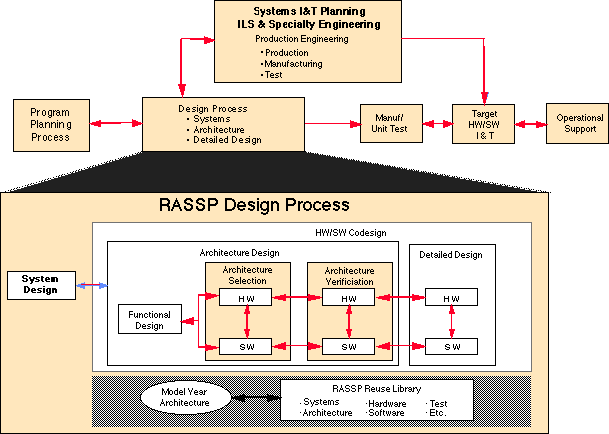Next: 2 Introduction Up: Appnotes Index Previous:Appnote Methodology Index
![]()
![]()
![]()
![]()
Next: 2 Introduction
Up: Appnotes Index
Previous:Appnote Methodology Index
Each major cycle of the spiral process represents an iteration of a virtual prototype. Within each prototype iteration, pieces of the design can and most likely will be at different levels of maturity, as shown in Figure 4 - 1. Each piece of the design may be represented by a mini-spiral where the spiral cycles correspond to virtual prototypes of the piece. Consequently, for each major spiral cycle, there may be activity in the system, architecture, and detailed design processes.
The overall RASSP development process, shown in Figure 1 - 1, has four major elements:
During the hardware portion of the detailed design process, behavioral specifications of the processor are transformed into detailed designs (RTL, and/or logic-level) through a combination of hardware partitioning, parts selection, and synthesis. Detailed designs are functionally verified using integrated simulators, and performance/timing is also verified to ensure proper performance. The process results in detailed hardware layouts and artwork, net lists, and test vectors that can then be seamlessly transitioned to manufacturing and test via format conversion of the data.
Since most of the software developments are verified during the architecture design phase, they are limited at this point to generation of those elements that are target-specific. This includes configuration files, bootstrap and download code, target-specific test codes, etc. All the software is compiled and verified (to the extent possible) on the final virtual prototype prior to the detailed design review. Design release to manufacturing marks the end of the RASSP design process.
1.0 Executive Summary
1.1 RASSP Methodology Design Process
The RASSP design process has three major functional processes - the systems, architecture, and detailed design processes. It is shown in expanded form in Figure 1 - 1. The process is partitioned as a function of the abstraction level of the evolving design, not as a function of the discipline. This is the result of merging hardware and software into a true codesign process; any distinctions between hardware and software are made within the specific process. Hardware/software codesign is implemented from the initial partitioning of functions to hardware and software elements all the way to manufacturing release. At each step in the hierarchy, interactive simulation using hardware and software models is performed at equivalent levels of abstraction to verify both functionality and performance. This means that each process area is closely tied to the RASSP vision of an iterative (spiral-like) development, resulting in a series of virtual prototypes and data packages.

![]()
![]()
![]()
![]()
Next: 2 Introduction
Up: Appnotes Index
Previous:Appnote Hardware / Software Codesign Index